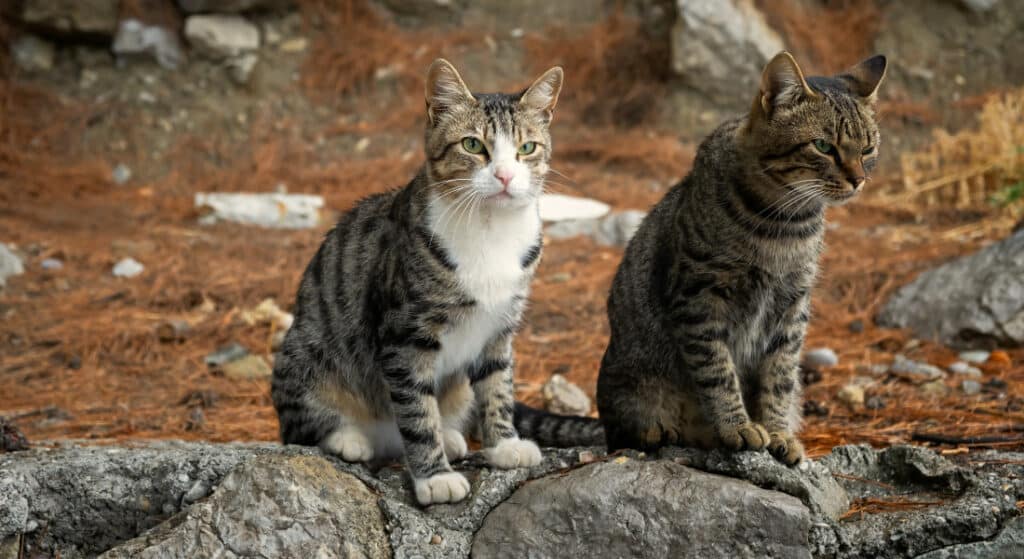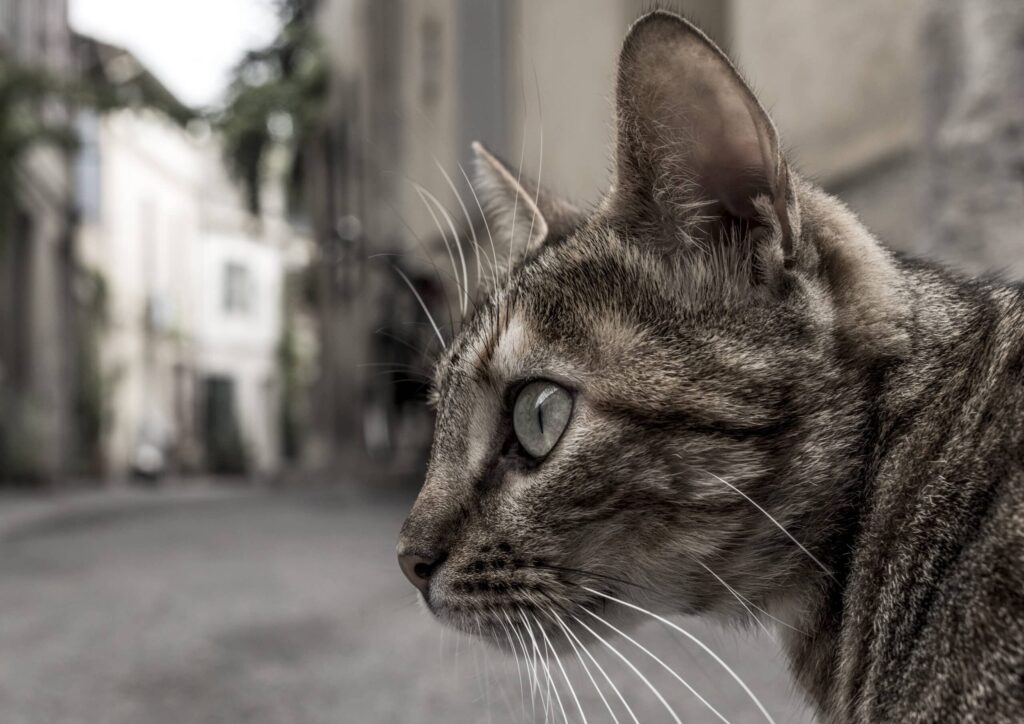
Are You Caring for Stray Cats? Let’s work together…
In quiet corners of our bustling cities and suburbs, stray cat colonies are exploding. These unowned felines are supported by an ‘army’ of people caring for stray cats. This article is for you if you’re one of these unsung heroes.
As the number of street cats grows and resources are stretched to breaking point, we desperately need to help each other care for stray cats. We can do that by…
- Pooling our resources.
- Cooperating to grow our combined social media reach.
- Using that social media reach to attract supporters and volunteers.
- Using our collective power to deal with obstructive institutions.
- Building supporters (an audience) that attracts sponsors that help provide resources.
This article is an open letter to everyone who feeds a stray cat colony. It explains why we need to connect, ways to support each other, and how we might build networks that help us better care for stray cats.
Vet Bills
By working together, we may be able to secure the help of a corporate veterinary chain and reduce or eliminate the cost of medical care.
Vacation
When colony feeders take a day off, their cats often go hungry. By cooperating we can cover for each other and finally take a much-needed break!
Food
Purchasing food in bulk, especially as part of a sponsorship deal can greatly reduce the biggest cost faced by every volunteer feeder.
Unsung Heroes
Behind the scenes, unsung heroes work tirelessly to care for stray cat colonies. The simple act of putting out a bowl of food is a lifeline for stray felines.
These volunteer heroes face challenges that range from steep veterinary bills to the never-ending need to provide sustenance.
As volunteers working alone, the task of feeding a colony of strays demands much of the individual. This is where the power of a community network can make a profound difference.
Vet Bills
One of the most pressing concerns for those caring for stray cat colonies is the cost of veterinary care. Stray cats are exposed to various health risks, from injuries to infections. These health issues require medical attention, but getting a stray cat to a vet requires various skills. Consider the challenges…
- The best time to trap is early morning or late evening.
- Cat colonies are often located in deserted spaces.
- Being alone in such places is often dangerous.
- Stray cats are often wary of humans and anything new that enters their environment.
- It may take several days to trap the specific cat needing attention.
- Trapping teams need refreshments and time for bathroom breaks.
- A colony cat may bite or scratch, requiring the person bitten to seek medical treatment.
A small group of feeders has less chance of obtaining medical attention for the cats under their care. This is why working together makes sense.

A Division of Labor Helps when Caring for Stray Cats
A cooperating local network can create a pool of willing volunteers across several colonies that help each other. For example…
- Cooperating groups might include several people with experience trapping strays. They can form a specialist team that serves all members.
- People may be willing to prepare and deliver refreshments to a trapping crew, who often face long waits in bad weather. A hot coffee and a snack is often a lifeline!
- Blankets, sunblock, sun hats, weatherproof clothing, towels, flashlights, batteries, and other equipment cost money. Across several groups, there may be people able to subsidize the costs for volunteers on low incomes.
- A cooperative can pool funds and prepurchase vet services in bulk, reducing the overall cost.
- Across many cooperating groups, there’s a good chance someone has medical training and can treat or advise anyone who gets injured.
- A medical person shared across several groups can operate on an ‘on-call’ basis. And the members of these groups can pool funds to purchase a better first aid kit.
This division of labor allows a cooperative to form. The members may then appoint a managing committee representing the groups as if they were a single entity.
Sponsorship
Within a city, State, or country, a cooperative can negotiate a sponsorship opportunity with a corporate Vet. As a corporate vet will have branches across the city, State, or country, it can provide services to every group in the collective.
A private Accident and Emergency clinic may be willing to sponsor the group. The result is a shorter wait time for injured members, getting them home faster.
Corporations like to support worthwhile causes. A corporate veterinary chain may work with a cooperative to provide medical services at a reduced cost or even free of charge.
A sponsor may want to promote the cooperative itself. This helps inform others about the group and attract more members.
More volunteers mean more resources, more time off, and better cat care.
Audience
In theory, those caring for stray cats could seek financial help via social media. But this requires a sizeable social media audience.
The available audience increases immediately when small groups cooperate and combine their existing social media reach. And it will explode exponentially if those groups pool resources to create content in an organized way.
The consistent production of engaging content showing the groups’ combined activities will attract followers. The social media team can then ask this audience for contributions, which will, in turn, encourage other groups to join, creating a virtuous circle.
Trapping
Trapping stray cats for medical care or rehoming is a difficult job at best. Let’s start networking so we can share skills and form specialist teams.
Funding
Most colony feeders lack the time, experience, and social media reach necessary to fund their activities. Let’s work together and fix that.
Politics
We can better oppose local bureaucratic and political measures that are hostile to cat welfare when we coordinate and work together.
Time Off
A colony fed by one or two volunteers results in people who never get time off. If those people don’t show up, the stray cats in their care go hungry.
A cooperative allows members to cover for each other to allow for vacations or to deal with a family emergency. By sharing responsibility in this way, we ensure the cats’ needs are met. The result is less stress for caregivers and improved colony welfare.
CatInfo.net can help by providing an online scheduling system that allows local cooperating groups to create a roster and book time off. Use our Contact Us Form to notify us if you want access to such a service.
Cat Food isn’t Free
Regular feeding is the cornerstone of colony care and comes at a cost. By forming local networks, caregivers can bulk purchase cat food and share the expense.
This reduces the financial strain on individuals and guarantees a steady sustenance supply for the colonies. Coordinated efforts can minimize food waste and ensure that each cat receives the appropriate nutrition.
On a city, State, or national level, attracting a corporate sponsor may be possible as Corporations like to support worthwhile causes.
A corporation may enjoy providing its food to members of the cooperative along with branded clothing that signals its willingness to support those who care for stray cats.
The Incidental Cost of Caring for Stray Cats
Caring for stray cat colonies extends beyond food and medical care. The cost of shelter improvements, bedding, and hygiene supplies quickly mounts up.
Those caring for stray cats know one never runs out of things on which to spend money!
Caregivers can share these expenses by collaborating with a local network, allowing for more comprehensive, coordinated, and holistic care across many colonies.
Community Awareness
Beyond the immediate benefits to the cats, local networks have the potential to raise community awareness about stray cat colonies. Working in conjunction with a sponsor further enhances community awareness.
A corporate sponsor is always keen to promote its benevolence and will seek to promote the activities of those it supports. Bringing public attention to the groups involved helps secure more volunteers.
When individuals join forces, things change for the better. A motivated group creates a visible presence that draws attention to an issue, fostering compassion and understanding among their neighbors.
Conclusion to Caring for Stray Cats…
Did you find yourself nodding along in agreement with the points made in this article? Would you like to discuss the idea of networking with us?
Join our Facebook Group now and introduce yourself. Let’s work out how we might improve the lot of the cats under our care. And share skills, competencies, and resources.
The need for united efforts in caring for stray cat colonies is undeniable. Caregivers can combine resources, share responsibilities, and amplify their impact through local networks.
The bonds formed within these networks enhance the cats’ well-being and enrich their caregivers’ lives. Let’s build a community of cooperating groups and support each other.













